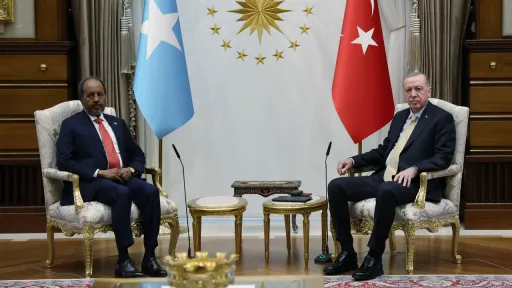By Fathiya Bayusuf
Khanga, or leso, is a rectangle-shaped cotton fabric printed in various colours with Swahili proverbs and sayings emblazoned at the bottom to convey social messages.
It goes beyond being mere clothing; it is an art form that signifies culture and beauty, particularly among the women of the East African coast.
Usually worn in pairs, a woman drapes the leso around her waist while the second piece covers her head - presenting an image of cultural identity and respect whether at home or during various ceremonies.
For women, the leso serves as a symbol of honour and love from their husbands. Accumulating numerous pieces of leso signifies more than just enhancing beauty, it is an expression of care and affection within marriage.
"The leso is akin to an ornament for a Swahili woman. Whenever she adorns it, she ascends to a level of significance and beauty. It transcends being a historical garment worn by our elders, especially the Kisutu style, which was popular at events like weddings or cultural festivals," notes Ms. Amira Msellem, a researcher specializing in Swahili traditions and cultures in Mombasa.
19th century roots
The history of leso is believed to have begun in the 19th century, particularly in the islands of Zanzibar, Pemba, and Mombasa. Over time, it gained popularity among coastal communities, leading to the emergence of various embellishment styles.
The initial designs featured white and black spots, reminiscent of the colours of a wild bird known as kanga. This is where the name "kanga" gained popularity and affection among the people.
"The early khangas had only white and black spots, without any writings. But as time progressed, they were enhanced with various patterns," explains Imran Abdul Haq, a leso designer at Abdullah's store.
Over the years, leso styles evolved, incorporating creative use of colours, flowers and intriguing images such as plants and animals.
In the early 21st century, Swahili writings, proverbs and sayings were added to the leso, believed to be the effort of a renowned entrepreneur, Kaderdina Haji Isaack, also known as Abdulla, the founder of the leso business in Mombasa.
Imran Abdul Haq, the leso designer at Abdullah's store, describes how his grandfather successfully distinguished his products and created a brand called "Mali ya Abdulla."
"Mzee Abdulla was the one who added Swahili writings to the leso style and the people of Mombasa loved it. Swahili women started sending messages through the writings on the khangas that they wore. Thus, we've expanded his business from khanga to a large store selling various African products like kaniki, vikoi, vitenge, and others," says Imran.
Initially, the writings on the leso, though in Swahili, were written in Arabic script and later in Roman letters as the use of khangas expanded from the coastal people to spreading throughout East Africa.
However, there's a distinction between Kenyan and Tanzanian leso. Imran emphasizes: "Our Mombasa khangas are known for their width, weight, and superior quality which is why many people love them."
The khanga is not just a fashion garment, it has become an integral part of Swahili culture and are used as a means of communication. The writings inscribed on them serve to express love, gratitude or even convey feelings of disagreement.
"Swahili women prefer using leso to convey messages. When they buy a leso, they choose writings based on the message they want to communicate. For example, khangas worn by new mothers may have a congratulatory message like 'Welcome, guest' or 'Thank you, mom, for nurturing,'" says Amira.
According to Amira, in the past, leso also served to indicate a girl's transition into adulthood.
"Leso served as a resource for women because it was customary for a woman to own many pieces of leso. Women owned leso as a way of saving to overcome financial challenges by selling them."
"Also, the leso was used in communication between spouses because sometimes women had difficulty speaking directly to their husbands. So, a woman would fold the leso in various patterns to convey a message to her husband," she adds.
Some leso are used in wedding ceremonies, pregnancy celebrations, circumcision ceremonies, or even funerals. Women also use leso to carry babies and during prayer.
"Leso is very important for a woman; it is a modest garment and is widely used for prayers, household chores, or even carrying babies on the back. Leso is a crucial part of the lives of the Swahili-speaking people, from birth to death."
"When a woman gives birth, she must wear leso for 40 days. They were also used in the upbringing of children and even as a baby carrier, tied under the bed. Leso is also given as a gift to a woman who has given birth or to a bride," emphasises Amira.
Despite the changes in time, leso continues to be an essential piece of African identity.
Today, khangas are sewn as traditional garments, used as decorations in wedding ceremonies and other cultural events. Also, the leso has been incorporated into international fashion trends.
Some women still hold onto the tradition of wearing of leso as a way of preserving their heritage.
"I still use leso at home because it is part of the identity of an African woman. I buy them considering the message to give as a gift on various occasions such as birthdays, weddings, or even for my parents,'' Kavira Neema, a Congolese citizen living in Mombasa says.
''I would advise my fellow women not to stop wearing leso, as wearing leso is celebrating and respecting our heritage," Neema concludes.
➤Click here to follow our WhatsApp channel for more stories.
























